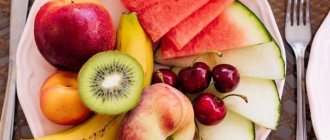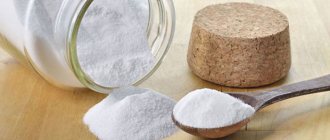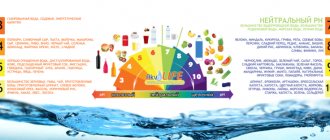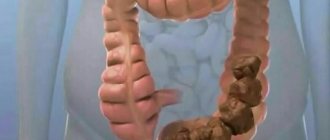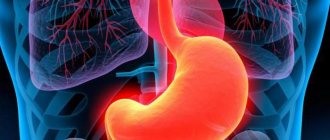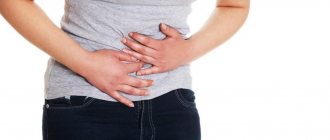How do citrus fruits affect the stomach?
People suffering from inflammation of the stomach often wonder whether lemon can be used for gastritis.
Citrus can bring a lot of benefits to the body, but for gastrointestinal diseases, this product is not recommended to be included in the diet due to the large amount of acids it contains, which can irritate the walls of the digestive organ. Why can’t you eat lemons if you have gastritis and in what cases can you make an exception to the rule?
To understand whether it is possible to eat lemon if you have an inflammatory disease of the stomach, it is worth determining how the fruit affects the digestive organ. Lemon contains a large amount of ascorbic acid.
This substance increases the secretion of gastric juice and irritates the walls of the organ, thereby causing increased symptoms of gastritis and contributing to the worsening of the disease. You should not eat lemon if you have gastritis with high acidity.
Advice
Prohibited products also include other citrus fruits - oranges, grapefruits, tangerines.
With hypoacid gastritis, characterized by a deterioration in the production of hydrochloric acid and a slowdown in digestion processes, lemons and oranges, on the contrary, can have a beneficial effect on the diseased organ if consumed in small quantities.
Fruits improve appetite, normalize food digestion and reduce unpleasant symptoms such as rotten belching and bloating.
However, during the period of exacerbation of chronic inflammation of the stomach, the use of these products must be completely abandoned so as not to irritate the walls of the organ and not increase the discomfort.
- It is allowed to include citrus fruits in the menu only for hypoacid gastritis during the period of remission.
- You can eat only a few slices of citrus per day, always after meals. The fruit must be peeled and consumed in its pure form, without adding sugar. Granulated sugar in combination with lemon juice has a negative effect on the gastric mucosa.
- It is allowed to add a piece of lemon to tea during breakfast.
- Lemon juice in its pure form can be consumed in an amount of 2-3 tsp. after meal. It is useful to mix it with apricot, peach, and pear juice.
- Lemon water, which many people drink to lose weight on an empty stomach, is not recommended for gastritis, since consuming citrus on an empty stomach during inflammation is harmful. You are allowed to drink natural non-carbonated lemonade, prepared at home, but only after meals, no more than 1 glass per day.
Despite the fact that doctors do not recommend eating lemons for gastritis, in folk medicine these fruits are often used in the treatment of inflammatory diseases of the gastrointestinal tract.
During the period of remission for gastritis, it is recommended to use a mixture prepared from 1 liter of calendula infusion, 3 tbsp. honey and juice of 1 lemon. You need to take the product 2-3 tbsp. l. 3 times a day before meals.
It promotes healing of the mucous membrane and reduces the likelihood of relapses.
With low stomach acidity outside the period of exacerbation, traditional healers advise eating 1 tbsp in the morning. l. honey mixed with lemon juice.
note
For breakfast, it is useful to eat oatmeal with milk and lemon (the juice is squeezed into a ready-made and slightly chilled dish). You need to eat this way for 2 weeks.
The recipe helps improve digestion and relieves unpleasant symptoms of the disease thanks to the enveloping properties of oatmeal.
Erosive gastritis is treated in alternative medicine using another proven mixture.
You need to take 0.5 liters of olive oil, 1 glass of honey and a few lemons. Combine honey and oil, squeeze juice from citrus fruits, add to other ingredients, mix until smooth. Take 1 tbsp. 3 times a day. The medicine should be stored in the refrigerator, in a closed glass jar.
Lemons are champions in ascorbic acid content, so consuming them is very useful for strengthening the immune system. But is it possible to eat lemon if you have gastritis, because this sour citrus can cause irritation to an already inflamed digestive organ. It is difficult to answer this question unequivocally, because the disease progresses in different ways, so recommendations are given to patients individually.
Beneficial features
Lemon has a pronounced sour taste, so it is used as a flavoring additive in drinks and dishes. Moreover, not only the pulp and juice are used, but also the zest of the fruit.
The main components of this citrus are water and citric acid; in addition, this fruit is a real storehouse of vitamins. And this is not only vitamin C, which everyone knows very well, but also other useful components, including vitamins A, D, B1, B2, P.
Advice! The juice of one medium fruit contains a third of the daily requirement of ascorbic acid, and 15 grams of zest - 12%.
Since this citrus contains a large amount of useful vitamins and organic acids, it is recommended to include it in the daily diet as a prophylactic against viral and colds. In addition, eating citrus fruits:
- heals blood vessels;
- saturates the body with antioxidants;
- reduces fatigue;
- helps in the fight against depression.
But, despite its valuable composition, lemon is not always useful for gastritis. To answer whether you can eat lemon with gastritis of the stomach or not, you need to know the type of disease.
The fact is that the disease can occur with both decreased and increased secretory function. Therefore, the approach to creating a diet will be different. But in any case, citrus fruits have an irritating effect on the mucous membrane, so fruits should be consumed carefully and in small quantities.
If the disease occurs with increased production of hydrochloric acid, then it is necessary to exclude from the diet all foods that further stimulate this function. These products include all citrus fruits. Therefore, in case of gastritis with high acidity, lemons are included in the list of foods prohibited for consumption.
In some cases, the disease occurs in such a way that gastric juice is produced in insufficient quantities. Is it possible to eat lemons with gastritis if the disease occurs with low stomach acidity? In this case, citrus fruits will be useful. But, of course, you don’t need to eat kilograms of fruit. They are used with a certain degree of caution.
Let's figure out how to properly use lemon for gastritis. Here are some recommendations:
- citrus fruits can be consumed with normal and low acidity;
- during an exacerbation, citrus fruits are excluded for any type of disease;
- You need to eat a limited amount of citrus fruits - 2-3 slices per day, no more;
- It is better to eat fruit not on an empty stomach, but after eating;
- It is better to eat citrus fruits without sugar, since the combination of lemon juice and sugar negatively affects the walls of the stomach;
- It is better to cut off the zest, despite the fact that it is very useful. The fact is that the zest is quite hard and it can mechanically irritate the digestive organs.
Lemon water
Lemon water with lemon for gastritis of the hypoacid type can be taken in the morning if it is well tolerated. Drinking such water stimulates metabolic processes. To prepare water, you need to dilute lemon juice with water so that the drink has a pleasant, slightly sour taste.
Advice! You should not drink cold lemon water; if you have stomach problems, you should take drinks at room temperature or body temperature.
Tea with lemon
Lemon tea is a popular drink. If you have low acidity, you can drink this tea. With high acidity, the drink can lead to aggravation, although everything is very individual. It is advisable to take tea with a piece of citrus only after meals, so as not to provoke irritation of the inflamed mucous membrane.
Contraindications
There are also contraindications to the use of lemons in food. An absolute contraindication is individual intolerance, that is, an allergy to citrus fruits. Patients with gastritis are prohibited from using citrus fruits:
- when the process worsens;
- with increased acidity;
- for heartburn;
- if discomfort occurs after taking citrus.
After an exacerbation, the diet should be expanded gradually. It is necessary to introduce potentially dangerous products such as lemon only after consulting a gastroenterologist.
So, lemon is not included in the list of products that are allowed to all patients with gastritis without exception. This issue must be resolved individually, taking into account the patient’s condition, type of disease, and the presence of concomitant pathologies. Therefore, the possibility of including citrus fruits in the diet should be discussed with your doctor.
Lemon for gastritis is indicated for diseases with low acidity. Its deficiency slows down the digestion process, resulting in food entering the stomach insufficiently digested. In this case, additional problems arise - gastritis and other gastrointestinal pathologies.
Lemons for gastritis
All citrus fruits are famous not only for their taste, but also for their beneficial properties. For example, lemon is a sour fruit that is valued not only in cooking, but also in medicine. The fruit is native to regions with sub- and tropical climates. In some forms of gastritis, fruits are even included in the therapeutic regimen.
In addition to lemons, there are other fruits that can sometimes be consumed for gastrointestinal disorders. For example, is it possible to eat oranges if you have gastritis? This fruit accelerates blood circulation, normalizes blood pressure, digestion and has anti-inflammatory properties.
Tangerines contain beta-carotene and fiber. They also help restore digestion. However, for all their beneficial properties, any citrus fruits (especially lemons) should not be consumed in case of some forms of inflammation of the mucous membrane (erosive, atrophic, etc.).
However, gastritis can also occur with low acidity. In this case, the mucous membrane also becomes irritated, but due to poor digestion of food. It partially remains in the stomach, and the processes of rotting and fermentation begin. To avoid this, it is recommended to consume sour fruits. Then the pH deficiency is replenished, which prevents injury to the mucous membrane.
Beneficial features
Gastritis and other citrus fruits
Almost everyone suffering from gastritis is concerned about the compatibility of their disease with the consumption of citrus fruits. After all, these are very healthy and tasty fruits, which have been associated with New Year's holidays and celebrations since childhood.
Oranges
- Have a positive effect on the circulatory system, strengthening vascular walls and thinning the blood;
- Pectins contained in the pulp cleanse the intestines and have a stimulating effect on the gastrointestinal tract;
- A wide range of vitamins enhances the functionality of the immune system;
- Orange juice, filled with phytoncides, prevents inflammatory and viral effects and activates the vital energy of organs.
Just like lemons, they are recommended for consumption only for low-acid forms of gastritis. Patients in remission are allowed to drink 100 grams of juice up to three times a day. Patients in the acute phase of the disease or with high acidity are not advised to consume citrus fruits.
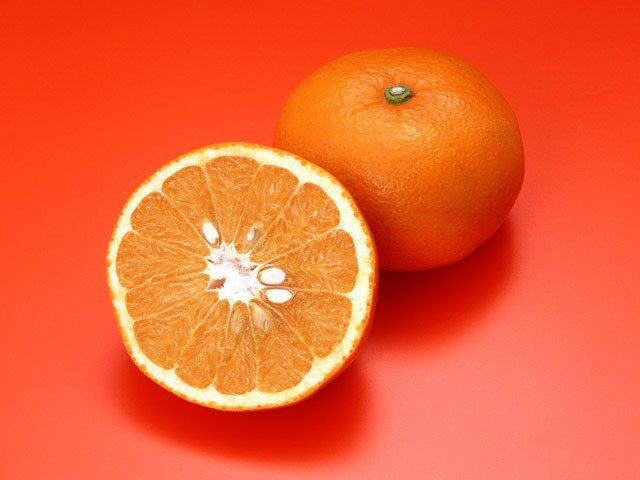
Tangerines
When compared with other types of citrus fruits, tangerines can boast the highest content of beta-carotene, which can prevent the development of cancer in the body. Plus, they are the sweetest and most flavorful of the bunch. Containing phenolic acid, tangerine juice is a drink widely used in the treatment of bronchial diseases, including asthma.
A glass of water with lemon in the morning: when a good habit becomes destructive
Honey is a waste product of bees, which is represented by a rich component composition. It contains vitamins, minerals, phytoncides, acids, enzymes, flavonoids. They determine the beneficial properties of nectar:
- reduction of symptoms of the inflammatory reaction;
- removal of edema;
- manifestation of antibacterial action;
- providing the body with useful substances;
- stimulating fermentation in the digestive tract, which makes it easier to digest incoming food;
- cleansing of toxins and other harmful substances;
- exhibits sedative properties;
- activation of healing processes.
These beneficial qualities are actively used in the pharmaceutical industry for the production of drugs based on bee products. However, it is better to take it in pure form or in combination with other components. For example, with milk, tea, water.
Mineral waters contain many beneficial substances. Among them:
- Calcium. Improves the condition of bones and teeth, protects blood vessels from penetration of pathogenic microflora, and has an anti-inflammatory effect.
- Magnesium. Stabilizes the functioning of the nervous system and is responsible for the strength of connective tissue.
- Fluorine. Promotes rapid healing of bone tissue.
- Iron. Stimulates the production of hemoglobin, protects the stomach from penetration of pathogenic microflora, strengthens the immune system.
- Bor. Positively affects the condition of bone tissue and cell membranes. Improves the functioning of the immune system.
- Vanadium. The lack of this substance negatively affects the functioning of the cardiovascular and nervous systems. Vanadium lowers cholesterol levels and is responsible for carbohydrate-fat metabolism.
- Cobalt. Participates in the metabolic processes of the body, breaks down complex substances that enter the body along with food. Improves the functioning of the nervous and immune systems.
Gastritis affects other organs and systems. The human body that takes water with a mineral composition receives many useful substances necessary for improving health.
Water with lemon wonderfully quenches thirst and saturates the body with essential vitamins, minerals and microelements. It also helps restore the acid-base balance in the body, which helps prevent disease and get rid of excess weight.
When we wake up, the tissues of our body are dehydrated and need water (which is why we mentioned the miraculous quenching of thirst) - to displace toxins and rejuvenate all cells. This morning smoothie helps get rid of internal toxins and normalizes the functioning of the kidneys and the functions of the digestive tract, making them work as efficiently as possible.
The advantages of this drink do not end there. Water with lemon promotes digestion: lemon juice stimulates the secretion of gastric juice. Cleanses the liver: Lemon juice stimulates the release of toxins from the liver. It also helps fight respiratory tract infections (this is due to the anti-inflammatory properties of lemon).
Water with lemon regulates natural intestinal motility and strengthens the immune system (lemon is a powerful antioxidant, it protects the body from free radicals).
Promotes proper functioning of the nervous system - it's still about lemon water. Depression and increased anxiety are often the result of a lack of potassium in the blood. Lemon is rich in potassium, which is necessary for the nervous system to send signals to the heart.
Note for athletes: reduces pain in joints and muscles.
Improved skin will be a pleasant bonus (vitamin C contained in lemon improves skin condition, rejuvenating the body).
Water with lemon is an assistant in the fight against excess weight. Lemons contain pectin fiber, which suppresses hunger.
There is a strong argument that water with lemon prevents cancer. This is because lemons are a powerful alkaline food. Numerous studies have shown that cancer cannot thrive in an alkaline environment. (Drinking lemon water is not a guarantee, but it is a precaution that you can take).
All of the above properties speak of water with lemon as some kind of elixir of youth, beauty and health. But still, let's talk about the other side of the coin: this method can be quite aggressive if you suffer from any of the following diseases:
- For diseases of the gastrointestinal tract (ulcer or gastritis). Taking such liquid on an empty stomach can lead to abdominal pain for people with high acidity.
- People suffering from kidney diseases. The bottom line is that vitamin B, which is part of citric acid, has a strong diuretic effect.
- In the presence of sensitive enamel. Citric acid can cause discomfort in the mouth because regular use of it thins tooth enamel. Dentists recommend using special strengthening toothpastes during a course of treatment with lemon water.
- For stomatitis. If you have wounds in your mouth resulting from injury or a viral disease, drinking lemon water is prohibited. It will cause severe irritation of the mucous membrane.
- If you are allergic to citrus fruits. Often, people may develop a rash on their body after eating large amounts of sour fruits. If you have a similar problem, for example, with oranges, then you shouldn’t eat lemons often. And the fact that the lemon is diluted with water does not change the essence.
To avoid negative consequences, go to an appointment with a gastroenterologist before a course of long-term use.
I absolutely agree with everything said above. Let me clarify one point: lemon juice does not contain pectin fibers, since the fibers remain in the pulp and skin. I do not recommend drinking more than two glasses, or adding honey. Honey on an empty stomach raises glucose levels above normal, and this in turn will provoke cravings for sweets throughout the day. Water with lemon and honey is best consumed between breakfast and lunch.
“Lemon water” doesn’t always have to be the same. In the constant classic version, water with lemon can get boring, then you just give it up. We offer you several options on how you can diversify this morning cocktail.
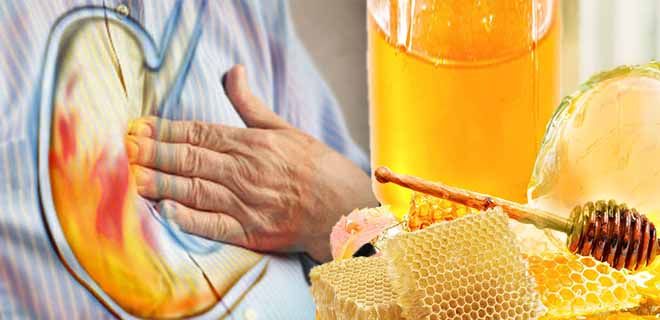
When we talk about the classic version, we mean 1-2 slices of lemon, poured boiling water (let it sit for 15 minutes and release its beneficial properties, and then drink in slow sips (if necessary, dilute with cool water). This lightweight drink is more intended for people who suffer from gastrointestinal problems, and it also has a slight tonic effect).
If you don’t have any problems with the gastrointestinal tract, and you want to stun and awaken your body in the morning, you can add fresh lemon juice and a pinch of cayenne pepper to the water. This way you will definitely start your metabolism.
For those with a sweet tooth, you can add honey to water with lemon (1 tsp will be enough to avoid excessive cloying). This variation will have a double cleansing effect on the body and strengthen the immune system’s resistance to viruses.
To make lemon water even healthier, you can add green tea leaves to it.
Pour 200 ml of boiling water over a few leaves, let brew for 10 minutes, then remove the tea leaves, and when the liquid becomes warm, add the juice of half a lemon. The drink will quickly remove toxins, and skin color will improve within a week of drinking this tea on an empty stomach.
Let’s briefly and to the point go over the principles of cleansing using lemon water.
You need to drink a glass of this miracle water in the morning, 20-30 minutes before meals. Only in this way will metabolic processes start in the body, and the ingredients of the liquid will begin to work as intended.
Drink only one glass of liquid. Do not overdo it. It is not excess that is important, but regularity.
Drink a freshly prepared drink so that the juice is freshly squeezed. Do not prepare water the night before! There will not be a single useful microelement left in it until the morning.
After taking this liquid, be sure to eat. Because of water with lemon, the stomach will produce gastric juice more intensely, so the meal should be complete, and not just a cup of coffee or tea. Healthy breakfast options for you: fitness candies (full of complex carbohydrates - what you need for breakfast), healthy sugar-free cookies, porridge, cottage cheese, egg dishes.
It is better to drink water through a straw: firstly, it is absorbed faster this way, and secondly, this way the contact with the teeth is minimal.
Lemon is the fruit of the tree of the same name. Belongs to the citrus family. Lemon juice contains a large amount of substances beneficial to the body - vitamins and microelements. The calorie content of 100 g of fruit is only 30 kcal. Carbohydrate component – about 4%.
The composition includes substances such as:
- Carotenoids;
- Vitamin A;
- A nicotinic acid;
- Pantothenic acid;
- Citric acid (8%);
- Vitamin B1;
- Riboflavin;
- Rutin;
- Thiamine;
- Calcium;
- Copper;
- Pectin;
- Apple acid;
- Galacturonic acid;
- Vitamin D;
- Vitamin B2;
- Fructose;
- Glucose;
- Ascorbic acid (60-80 mg);;
- Phytoncides;
- Essential oils.
This composition determines the wide range of beneficial properties that this fruit has. The main ones:
- Natural antiseptic – disinfects, reduces inflammation;
- Anti-inflammatory property;
- Regulation of metabolic processes;
- Regulation of acidity (recommended for gastritis due to low stomach acidity);
- Strengthening the immune system (increases the body's ability to resist inflammation).
Despite the large number of useful substances, you need to know that consuming lemons can be harmful to health:
- Allergy;
- Increased acidity;
- Heartburn.
Is Lemon Acid or Alkaline? 10 ways to equalize the body's Ph balance
Many people have increased acidity levels in their bodies.
This is a typical consequence of eating processed foods, refined sugars and GMOs. However, not everyone realizes that an acidic environment is ideal for the development of cancer, excess weight, pain and many diseases.
Fortunately, creating an alkaline environment in the body is very simple. An alkaline environment is the exact opposite of an acidic environment.
Here are 10 natural ways to ensure your body leach:
1. The most important thing is to start the day with a smile and a large glass of water with the addition of freshly squeezed juice of one lemon. Although lemons seem sour, they have the opposite effect on the body. Drink this drink on an empty stomach to cleanse your stomach.
Another option is to drink 1-2 glasses of natural apple cider vinegar with water daily. 1-2 tablespoons of vinegar per 220 ml of water is enough.
2. Eat large portions of green salad dressed with lemon juice and good quality olive oil. Green vegetables and fruits are one of the best sources of alkaline microelements such as calcium. Eat them throughout the day to maintain a healthy pH balance in your body.
3. Would you like to have a snack? Eat raw unsalted almonds. It contains many alkaline microelements such as magnesium and calcium, which restore the acid-base balance and also normalize blood sugar.
4. Drink almond milk and make yourself berry smoothies with green powder like spirulina. If given a choice, almond milk is always preferable to cow's milk.
5. Go for a walk or exercise. Activity is extremely important. Physical exercise helps remove acidic foods from the body.
6. Breathe deeply. Ideally, you should find a place with clean, oxygenated air and visit it whenever possible. There (and not only there) you should drink more water to remove toxins from the body.
7. Don't eat meat every day. If you can tolerate a few days without meat, that's great, because eating meat every day leaves behind acid deposits.
8. Avoid desserts high in sugar and sweet soda. Sugar is one of the most dangerous acidic foods. It takes over 30 glasses of water to neutralize the acidity from one can of soda!
9. Include more vegetables in your diet. Please note: potatoes do not count! Peppers, asparagus, zucchini and eggplants will be very useful.
10. And finally: eat more Brussels sprouts. It leach perfectly and contains a lot of nutrients and beneficial enzymes.
Afterword - some scientific data:
| Acid load of staple foods* | |
| Product | Acid load |
| Sour foods | |
| Meat | 67,9 |
| Cereals | 13,8 |
| Cheese | 4,2 |
| Milk and yogurt | 2,8 |
| Eggs | 2,5 |
| Neutral products | |
| Legumes | 0,8 |
| Nuts | 0,1 |
| Alkaline products | |
| Leafy greens | -59,1 |
| Vegetables from the fruit group** | -46,5 |
| Roots | -26,4 |
| Vegetables | -14,3 |
| Tubers | -10,6 |
| Fruits | -5,8 |
| Notes: | |
| * in milliequivalents for 240 kilocalories | |
| ** Vegetables from the fruit group: tomatoes, cucumbers, zucchini, eggplants, cucumbers, watermelons, melon, pumpkin, etc. |
Acidification of the body - an introduction to the problem
We know that food supplies us with energy, building substances (proteins, fats, carbohydrates) and vitamins. It turns out that food has another important property. It can either acidify or alkalize the body.
American scientists made a fundamental discovery at the beginning of the 21st century. They proposed a way to measure the acidity of the diet and showed that it is chronic acidification of the body that is one of the main reasons for the leaching of calcium from bone tissue and its massive release through the kidneys. As a result, bones are destroyed and kidney stones form.
By regularly consuming 1-2 teaspoons per day of the mineral preparation ORTHO CALCIUM + MAGNESIUM, you can ensure an optimal level of alkalization of the body. So, more details.
The power of hydrogen
Life processes take place in aqueous environments, which are characterized by a certain concentration of hydrogen atoms. Substances that donate hydrogen atoms are called acids, and those that take them away are called alkalis.
The acid-base ratio is characterized by a special indicator of free atoms in a solution. It is called pH (from the Latin “potentia hydrogeni” - “the power of hydrogen”). In a neutral environment, the pH is 7.0. In an acidic environment, pH is below 7 - from 6.9 to 0.
In an alkaline environment, the pH is above 7 - from 7.1 to 14.0.
Strict control of acid-base balance
Normally, blood has a slightly alkaline reaction - 7.35-7.45. pH is very strictly maintained within narrow limits, since only under these conditions is the work of most enzymes possible. When exposed to acidifying or alkalizing factors, the body uses the body's compensatory reserves. In general, the body’s resistance to alkalization is several times higher than to acidification.
Acid load is a new dimension of food. We are accustomed to evaluating food in terms of calorie content, protein content, carbohydrates, fats, vitamins and other substances.
American scientists at the beginning of the 21st century made a genuine discovery when they showed that any product has another fundamental indicator that is critical for our health. They called it NEAP (net endogenous acid production). Simply put, this is the acid load of food.
It consists of the ratio of components in food that, during metabolism, form either an acid or an alkali. The acid load is measured using the principle: acid minus alkali. When components that form sulfuric acid (sulfur-containing amino acids) or organic acids (fats, carbohydrates) predominate in food, then the acid load has a positive value.
If the food contains more components that form alkali (organic potassium and magnesium salts), then the acid load is a negative value. Computer analysis made it possible to determine the acid load of basic food products.
Improper nutrition is the cause of chronic acidification of the body
Human biochemical processes have a long history of formation in relation to the nutritional conditions that accompanied it during evolution.
Reconstruction of the image of a Neanderthal
It is believed that three large stages can be distinguished in the history of human nutrition:
- The food of ancient man, which our ancestors ate for 5-7 million years.
- Human food is an agricultural culture that arose about ten thousand years ago.
- The food of modern man, which he began to consume in the last 100 years and which has changed especially dramatically over the past 20 years.
For 99% of history, man has been a hunter and gatherer. According to anthropologists, about a third of his diet consisted of lean meat from wild animals and two thirds of plant foods. Under these conditions, the diet was exclusively alkaline in nature, the acid load averaged minus 78 milliequivalents per day.
The situation changed fundamentally with the emergence of agrarian civilization, when people began to eat a lot of grain crops, dairy products and fatty meat from domesticated animals.
But particularly dramatic shifts in nutrition occurred at the end of the twentieth century, when industrially processed “sour” foods filled the diet. The acid load of modern human food is plus 48 milliequivalents per day. Daily “acidic” nutrition leads to chronic lifelong acidification (acidosis) of the internal environment of the body.
Chronic acidification is the source of many health problems
The body does not allow the blood pH to go beyond the specified limits, but this comes at a high price:
- The skeleton is sacrificed, since for the purpose of alkalization, calcium is washed out of the bones. Hence the back pain that plagues modern people. And also, the development of osteoporosis is sharply accelerated.
- Muscles are destroyed. Chronic weakness and muscle pain are observed already at a young age, but the elderly are especially affected.
- Weak bones and muscles lead to joint dysfunction.
- Acidic urine creates ideal conditions for the formation of kidney stones . This is taking on the character of an epidemic. Chronic renal dysfunction causes the development of inflammatory diseases and renal failure.
- The acidic reaction of saliva destroys teeth.
- Chronic acidification can also cause hypothyroidism, headaches, anxiety, insomnia, low blood pressure, fluid retention in the body and other disorders, including the development of cancer.
Measure the pH of urine and saliva
Fortunately, there are simple indirect methods for determining the pH of liquids using test strips that change color differently depending on the pH value.
The most convenient way to assess the state of acid-base balance is by pH of urine and saliva. To do this, the test strip is moistened with urine or saliva.
Comparing the color of the test strip with a color standard allows you to determine the pH level.
Urine pH. It is believed that among primitive people, urine was alkaline, its pH was approximately 7.5-9.0. For modern people, the norm is in the slightly acidic range: from 6.0-6.4 in the mornings to 6.5-7.0 in the evenings. On average it is 6.4-6.5. It is better to measure urine pH on an empty stomach, 2 hours before and after meals, 2 times a day several times a week.
Saliva pH The optimal time to measure saliva pH is from 10 to 12 noon. Normally, the pH of saliva is in the range of 6.5-7.5.
Return pH to normal
If the pH deviates in the acidic direction, it is necessary to increase the content of alkaline foods in the diet (see table) and engage in more aerobic exercise, for example, 30-40 minute walks at a fast pace 4-5 times a week are good.
Literature:
- Borovsky E.V., Leontyev V.K.
Biology of the oral cavity. – M.: Medicine, 1991, 301 p.2. Zaichik A.Sh., Churilov L.P. Pathophysiology of acid-base balance. In the book: Fundamentals of pathochemistry. – St. Petersburg, Elbi, p. 334-353.3. Alpern RJ, Sakhaee S. The clinical spectrum of chronic metabolic acidosis: homeostatic mechanisms produce significant morbidity. Am J Kidney Dis 1997; 29:291–302.4. Eaton SB et al. Paleolithic nutrition revisited. In: Evolutionary medicine. New York: Oxford University Press, Inc, 1999:313–32.5. Eaton SB, Cordain L. Evolutionary aspects of diet: old genes, new fuels. Nutritional changes since agriculture. World Rev Nutr Diet 1997; 81:26–37.6. Milton K. Hunter-gatherer diets—a different perspective. Am J Clin Nutr 2000; 71:665–77. Encyclopedia of Natural Medicine by Michael Murray, ND Prima Publishing (Revised 2nd Edition).8. Sebastian A. et al. Estimation of the net acid load of the diet of ancestral preagricultural Homo sapiens and their hominid ancestors. American Journal of Clinical Nutrition. 2002; 76(6):1308–1316. 9. Simopoulos AP. Evolutionary aspects of nutrition and health: diet, exercise, genetics and chronic disease. Basel, Switzerland: S Karger, 1999.
June 7, 2008. Sergey Aleshin , Candidate of Medical Sciences
Source: https://gruzdev.org/limon-kislota-ili-shheloch-10-sposobov-vyrovnyat-ph-balans-organizma/
Tea with lemon can be used for gastritis - Treatment of gastritis
Treatment of gastritis with beekeeping products depends on the diagnosis. The intake is affected by the acidity in the stomach and other features of the disease.
In addition to honey, bee products such as bee bread, pollen and royal jelly are widely used in alternative medicine.
Bee bread is a valuable product with a lot of beneficial properties for the body. For gastritis, it is best to consume bee bread with honey (1:1). If the disease is accompanied by an increase in acidity, then the mixture is dissolved in water at room temperature. Take a teaspoon three times a day.
Bee bread can also be added to infusions and decoctions of herbs (chamomile, plantain, sage).
Royal jelly is a rare beekeeping product that has a powerful immunostimulating effect. For the treatment of gastritis, milk is used in a mixture with honey or herbal infusions.
For increased gastric secretion, prepare an infusion, for which you take 20 grams of mint, linden, calamus and 10 grams of fennel. The mixture of herbs is poured into 500 ml of boiling water and left for 3 hours.
Drink a glass 3 times a day before meals. Along with the infusion, take ½ teaspoon of royal jelly with honey (1:100) 20 minutes before meals.
If the acidity is low, then take 20 grams of calamus, caraway seeds, and wormwood as herbs for the decoction. 2 tablespoons of the mixture are poured into 500 ml of hot water and boiled for 10-15 minutes over low heat.
Strain, cool and drink 100 ml half an hour before meals. At the same time consume ½ tsp. royal jelly with honey in a ratio of 1:100 by slow resorption.
Pollen contains a large amount of biologically active substances and has an extensive list of medicinal properties. For gastrointestinal diseases, it is used both in pure form and in a mixture with honey and herbal infusions.
In case of increased acidity, it is necessary to take pollen (½ tsp) simultaneously with an infusion of herbs, which includes St. John's wort, knotweed, plantain, and mint.
If the acidity of gastric juice is reduced, then the herbal mixture includes in equal quantities: calamus, centaury, wormwood. The finished drink is taken with ½ tsp. pollen.
Traditional medicine recipes
- Excluding acute periods of illness, at all other times, the following remedy is useful for daily use: 1 liter of calendula infusion, juice of 1 lemon, 3 tablespoons of honey - mix and consume 30 grams, 3 times a day before meals;
- Also during the period of remission, it is recommended to have breakfast for a month with warm oatmeal with milk, with lemon juice added directly to the plate, immediately before meals. And before meals, take a tablespoon of honey with lemon juice. This diet stimulates increased production of gastric juice, and the surface-coating properties of oatmeal relieve inflammation of the gastric mucosa;
- Honey, lemon and olive oil - mix in equal parts, take 1-2 tablespoons before meals;
- Eat 2-3 green apples, mashed into puree, every day;
- Before meals, before breakfast, lunch and dinner, drink half a glass of decoction from a special herbal collection.;
- Dilute a tablespoon of honey in a glass of warm water. Drink during the day before meals;
- Healing tincture of walnuts is a cure for a hundred diseases. It has a beneficial effect on the health of the endocrine system, gastrointestinal tract, and increases the level of acidity. Take a tablespoon diluted in warm water after meals.
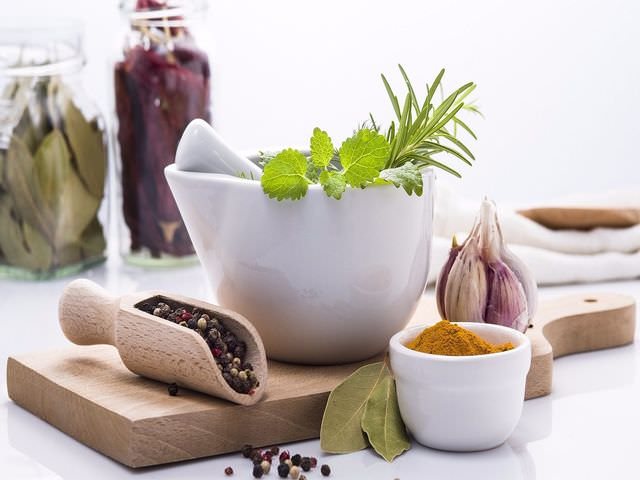
Side effects and contraindications
Despite the fact that doctors do not prohibit consuming honey, there are certain contraindications for some patients:
- Allergic intolerance. If you are not sure whether you have an allergy, eat ½ teaspoon of the product. After a while, observe the body's reaction. If no rash, irritation or itching appears on the skin, then there is no allergy.
- Diabetes. The body cannot cope with the absorption of carbohydrates, and honey will create additional stress on the pancreas.
- Diarrhea. Natural sweetness has a laxative effect and is used to relieve constipation. Therefore, eating it during diarrhea is extremely undesirable.
Gastroenterologists completely prohibit treats if gastritis or ulcers are in the acute stage. With this course of the disease, the list of permitted products is reduced to a minimum. Pregnant girls are advised to eat a small portion of sweets to make sure there is no allergy, even if they have not previously noticed any reactions.
The negative effect of lemon is expressed in an increase in the concentration of acid in the stomach, which can worsen the health of a person suffering from gastritis. In addition, under the influence of an irritant, the inflamed gastric mucosa begins to work harder, which reduces the effectiveness of treatment and causes pain. In some cases, vomiting and severe nausea are present.
Diet for cholecystitis
Therapeutic nutrition for cholecystitis (inflammation of the gallbladder) is necessary to normalize the processes of bile secretion and relieve inflammation. This disease is manifested by the secretion of less bile, due to which normal digestion is disrupted in patients and the absorption of fats is difficult.
A proper diet for cholecystitis excludes the consumption of heavy fats and all irritating foods, including smoked foods, sour foods, cold foods, and alcoholic drinks. The menu of a person with gallbladder pathology consists of easily digestible fats, and foods that stimulate the production of bile are indicated.
For patients, healthy foods are rich in magnesium salts: apricots, buckwheat. To maintain normal levels of cholesterol in bile, the menu includes plant foods, mineral waters, and vegetables.
The therapeutic diet for cholecystitis against the background of cholelithiasis has several goals:
- chemical gentle nutrition for the liver;
- complete caloric nutrition;
- normalization of the function of the biliary system;
- control of cholesterol levels (especially in case of gallstone disease);
- eating small meals frequently;
- exclusion of aggressive substances: fried, smoked, salted, fatty foods.
For cholelithiasis and cholecystitis, diet table No. 5 is prescribed - a specially designed therapeutic diet for people with diseased liver and biliary tract.
Nutrition is based on the following principles:
- The consumption of fats is limited, the amount of carbohydrates is reduced, proteins remain at the same level.
- Dishes are prepared exclusively by steaming, baking or stewing, and you can also eat raw foods.
- Hot and cold foods are excluded.
- Diet No. 5 limits salt intake.
- Products that cause flatulence, constipation, or stimulate the production of gastric juice are prohibited.
List of useful and permitted products for liver diseases:
- Lean meat and poultry: the menu is diluted with chicken, seafood, and premium sausages.
- Oatmeal, buckwheat and pasta are allowed for cholelithiasis. You can prepare puddings, porridges, casseroles.
- Non-acidic vegetables and fruits: Fresh produce is rich in vitamins and dietary fiber, which are essential for healing and maintaining digestion.
- Dairy products of low fat and acidity: the patient can include cottage cheese, sour cream, yogurt with bifidobacteria in the menu.
- The patient can eat the following sweets: jam, marshmallows, marmalade.
- Drinks should be natural, it is recommended to drink mineral water, but completely avoid soda with dyes, energy drinks and alcohol.
Prohibited foods
List of products strictly prohibited for cholecystitis:
- Fatty meat and fish products.
- Legumes, peas, beans: foods that cause bloating.
- Mushrooms, canned foods, marinades.
- Alcoholic drinks, soda and strong coffee, tea.
- Sour berries, fruits and vegetables.
- Products that irritate the stomach walls: spinach, radishes, essential oils.
- Spices, fried foods, rich broths, hot sauces.
Sample menu for gallstone disease and cholecystitis:
- Breakfast consists of meatballs, semolina porridge, and tea.
- Second breakfast includes an apple and dried fruit with yogurt.
- For lunch, vegetable soup, salad and fruit compote.
- The afternoon snack consists of rosehip infusion and white crackers.
- Dinner includes tea, oatmeal cookies, cutlets.
- Before going to bed, you can drink milk or eat cottage cheese.
Tips and tricks
The main advice that should be given to those suffering from gastritis is that even if the doctor has allowed to include lemon in a nutrition or treatment program, you should not overdo it in its use - just 1-2 cloves are enough to get the necessary set of vitamins and microelements, support the body and strengthen it .
Consultation with your doctor is an important step on the path to recovery. It is forbidden to independently draw up a therapy program, since self-medication without the appropriate knowledge can aggravate the condition. You should also completely give up bad habits - first of all, drinking alcohol.
Thus, lemons for gastritis can be part of a treatment program, but only after consultation and examination with a doctor.
Can lemon juice seriously increase acidity?
In addition to potassium, lemons contain a lot of sodium and calcium. Their deficiency is much more dangerous than high acid levels in the stomach. According to some doctors, lemon in a reasonable dosage cannot seriously affect acidity. Therefore, when consumed in moderation, the fruit is even beneficial.
Schisandra seeds will help bring stomach secretion back to normal (increased or decreased). Drink the juice obtained from the fruit or consume two grams of the powder daily. The painful gastric disease syndrome will quickly go away.
Gastritis is an inflammatory process that occurs on the gastric mucosa. The main signs of the disease are acute and prolonged pain, disturbances in the gastrointestinal tract and heartburn. It occurs against the background of poor nutrition and bad habits. Gastritis requires serious therapy, which includes dietary restrictions and taking special medications.
How to take honey for gastritis
Treatment of gastritis with honey is possible only after visiting a gastroenterologist. The patient needs to get advice from a doctor and find out whether this product will be useful in his case.
When going to the hospital, you need to undergo laboratory and instrumental examination and confirm the diagnosis. Self-medication is strictly prohibited. Therapy should be comprehensive, and taking honey should be combined with medication, diet, and giving up bad habits. Only in this case can you count on a satisfactory result.
There are universal recipes for improving well-being for gastritis of any type and shape.
This substance works well for this disease on its own.
To do this, take it 4 times a day, 1 teaspoon and wash it down with water. The first time is in the morning before eating, and the last time is before bed.
Water with honey
Honey regulates the production of pepsin and hydrochloric acid. Therefore, honey water is suitable for both low and high acidity.
Dissolve 1 tablespoon of bee product in 200 ml of warm water (not higher than 40 °C). The temperature of the solution is very important, since warm water helps honey to be absorbed better. This drug is drunk 2 times a day between meals.
The duration of therapy should be 2 months, which will have a beneficial effect on the patient’s well-being.
Milk and honey
If a person experiences heartburn while using this remedy, then you can use milk with honey. It has a positive effect on various pathologies of the digestive organ, including peptic ulcers. Has a calming, enveloping effect.
Helps with gastritis of any origin and stomach ulcers.
- To do this, take 20 g of dried plants: chamomile, calendula officinalis, string, plantain, yarrow.
- The mixture of these herbs is poured into 0.5 liters of boiling water and kept on fire for up to 5 minutes. Leave for an hour and strain.
- Take a glass of warm herbal decoction and put a spoonful of natural honey in it. Take this remedy up to 4 times a day. Duration of treatment: 3 weeks.
Shilajit and honey
This remedy can heal ulcers and restore health after gastritis. Shilajit is extracted from resin-like substances found in rock cracks. It is sold in specialized retail outlets or pharmacies. It must be combined in equal proportions with a beekeeping product.
Take on an empty stomach 3 times a day for a month. And those who are very busy and do not have time to prepare this drug can purchase a ready-made drug containing these components at pharmacies. The instructions describe methods of treatment for various diseases.
Bee bread with honey
These are two bee products. Bee bread is also called bee bread. This is pollen carried by insects on their hind legs. It, like honey, has a huge amount of useful substances.
By consuming these two bee products, you can regenerate the damaged gastric mucosa. Connect them in equal parts. This mixture should be eaten 2 hours before meals. If desired, you can dilute one serving with warm water and drink.
Plantain juice is a remedy that has an anti-inflammatory effect. It is made by passing fresh grass leaves through a juicer.
- To make the juice more uniform, it is heated in an amount of ½ liter. No need to boil!
- Dilute ½ liter of natural honey in warm juice and stir until smooth. The result is a highly concentrated syrup.
- You need to take 2 tbsp. spoons of this liquid and dissolve in ½ glass of water. If the acidity is high, the water should be slightly heated, and if the acidity is low, it should be cooled slightly. Take 10 minutes before meals. The duration of treatment is 3 weeks.
